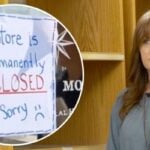A grocery store in Canada is sending a strong message amid U.S. President Donald Trump’s trade war with the country — going 117-plus days without selling any U.S.-grown fruits or vegetables, according to Global News.
“We’re, you know, just really trying to promote the local farms,” Garth Green, general manager of Urban Grocer, told the news outlet in a story published July 14. “It’s been very, very good for us. The customers have been very appreciative of it.”
Green says the store, located in Victoria, British Columbia, made the bold move to go cold turkey on American produce after Trump first imposed tariffs on Canadian goods in March.
Don’t miss
- I’m 49 years old and have nothing saved for retirement — what should I do? Don’t panic. Here are 6 of the easiest ways you can catch up (and fast)
- Want an extra $1,300,000 when you retire? Dave Ramsey says this 7-step plan ‘works every single time’ to kill debt, get rich in America — and that ‘anyone’ can do it
- Robert Kiyosaki warns of a ‘Greater Depression’ coming to the US — with millions of Americans going poor. But he says these 2 ‘easy-money’ assets will bring in ‘great wealth’. How to get in now
“There’s people every day almost that come in here and say, ‘You know, we hear what you’re doing and we love it and we’d love to join on board with you and really shop here,’” Green said.
Despite the success of the project, Green says it has also brought challenges.
Supply challenges
Green says the grocer has taken a “Canada-first” approach to sourcing its products, but the reality is not everything can be found in Canada at all times.
At one point, Green thought they could only get cauliflower from the U.S., per Global News, until he found out it was cauliflower season in Holland.
“So we reached out to a few suppliers and said, ‘Hey, can you get Holland cauliflower for us?’” he recalled. “We ended up finding some, brought it in, and you know it’s a little bit more expensive to bring in because you’re flying it in. But we just took a [lower] margin, [sold] it at a regular price and [were] able to give the customer something that they can buy until B.C. cauliflower was available.”
Supply is also an issue, and Green admits they’ve had to buy extra to maintain stock.
It’s all part of a cross-country trend of Canadian consumers avoiding U.S. products.
Read more: You don’t have to be a millionaire to gain access to this $1B private real estate fund. In fact, you can get started with as little as $10 — here’s how
Canadians reject American-made goods
Sylvain Charlebois, a food researcher at Dalhousie University, says what’s happening at Urban Grocer reflects the way Canadians have been spurning U.S. goods lately.
“The boycott is absolutely real,” he told Global News.
A report by marketing research firm NielsonIQ shows, amid trade tensions, nearly half (45%) of Canadian consumers are avoiding U.S. products or opting for Canadian-made alternatives.
“What’s really interesting is that people haven’t really boycotted chains like Walmart or Costco, but they’re boycotting products,” Charlebois said.
Canada has traditionally been one of the biggest buyers of American agricultural goods. According to the U.S. Department of Agriculture, in 2023, Canada made up 16.3% of U.S. agricultural exports.
It’s not known how long Canadians will maintain a boycott mindset, but Urban Grober is leaning into the trend.
“Across the store, we are working towards trying to go all Canadian if possible,” Green said. “It’s going to be a lot harder, but we’ve started the process and started to weed out some of the suppliers that we don’t need.”
What to read next
- Financial aid only funds about 27% of US college expenses — but savvy parents are using this 3-minute move to cover 100% of those costs
- Here are the 6 levels of wealth for retirement-age Americans — are you near the top or bottom of the pyramid?
- Here are 5 ‘must have’ items that Americans (almost) always overpay for — and very quickly regret. How many are hurting you?
- How much cash do you plan to keep on hand after you retire? Here are 3 of the biggest reasons you’ll need a substantial stash of savings in retirement
Money doesn’t have to be complicated — sign up for the free Moneywise newsletter for actionable finance tips and news you can use. Join now.
This article provides information only and should not be construed as advice. It is provided without warranty of any kind.







